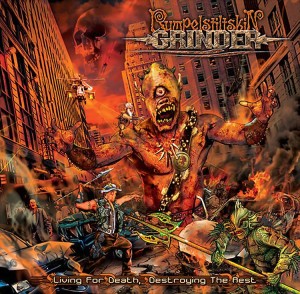
By Kyle Harcott
It’s so refreshing when you find an album that once more stokes the fire of your love for a genre of music previously thought lost. Last year, my taste for anything remotely post-metal was severely diminished shortly after I attended a Red Sparowes gig. It’s not that I didn’t enjoy the show -I did, immensely- I just got to a point where everything the genre had on offer started to sound so similar, I just didn’t have the patience to sit through yet another slow-burning magnum opus. I rounded out 2010 without even a thought for post-metal.
But then along came Roots Into The See, from Oakland’s Atomic Bomb Audition. The band’s third outing in five years, Roots… is a sprawling, shape-shifting record. Definitely a strain of fruit borne of the Neurosis tree, the Atomic Bomb Audition are among those brave acolytes who learn from their masters and hone what they’ve learned into their own craft. Not content to be imitators, instead the style is innovative and bold, and if I may, game-changing – for a genre not known for its eclecticism.
The absolutely ferocious “Limit” begins the record – an open-door view to great, yawing abysm. With a tortured vocal skirting the edge of post-black-metal (by way of Today is the Day), and thick, cloying guitars that crack like ice-breaking anchors, the song is a slow-motion drag under ice-cold waters. It is the sound of hypothermia’s stab ice-picking your brain moments before you calmly accept the inevitability of the drown. Midway there’s scant hope -amid mid-tempo roar and howl- like somehow you’ll manage to break the surface and see the sun once more – but the song degenerates into desperate lurching agony towards its end. Truly, all hope is lost. At 3:56, “Limit” is the shortest song on the album, but it is a striking and menacing introduction.
“Horizons” follows, the first of the album’s two three-part opuses, and instantly the mood is 180° different from the previous song. Beginning more cautiously, ominously, the first movement of the song is richly layered and feels like a long-awaited sunrise after a particularly vicious spell of blackest winter. The clean vocals are a welcome surprise in juxtaposition to the previous song. By the time those morose, spiraling guitars finally stomp distortion hell, about 4½ minutes in – a new day is rising. The layering and production really shine throughout the album, everything is mixed to perfection. The movement weaves and rises, wending its way to a frantic, rapturous crescendo, layered snare drum rising, firing like a twenty-one-gun salute on endless delay, only to fall away as suddenly. The second, instrumental portion of “Horizons” begins tentatively, loping its way into a drawling groove, where it remains – acting as a bridge between acts I & III, and showcasing the impressive lead guitar solo work of Alee Karim. Meanwhile, Brian Gleeson’s drunken drum groove pilots the ship throughout. The third movement ties it all together, continuing that same drunken groove of the previous movement, but with far more death-march drive and urgency. The vocals kick in, plaintive and mourning, and we finally get the feeling for what the whole song was about all along. This final portion of the song spotlights the band’s tremendous power as a unit – all four cylinders firing in the same direction and it’s quite the show of force – yet with just enough restraint and subtlety to keep the song from ever boiling over.
While all three of the album’s tracks are masterful in their separate realms, it’s “Bas”, on the record’s second side, which struck me as the standout. From the get-go, the song evokes a mood of haunted yearning not seen in the other tracks, something that really struck a chord with me. While it’s another show of restrained force, there’s a certain stride felt here on “Bas” that is particularly inviting. The instrumental layering is also by far my favorite, and the electronics work of The Norman Conquest figure a little more prominently here than on the previous two tracks. The three movements of the song could act as separate songs in and of themselves, but the way they tie into this one epic piece works so well. The heavy psychedelic abandon of the song’s third movement is stunning, almost in a similar vein as later-day Red Sparowes but far more compelling than I’ve ever found that band. The song ties itself into a neat little bow with some clever heavy-prog flourish at the end, and all that is left is the echo.
A labor of love, Roots Into the See was recorded and engineered with the vision of being pressed on vinyl well in mind. And what a package! The limited-edition-of-500 record is pressed on virgin 200-gram vinyl and sounds absolutely stunning, especially when played on headphones. There’s a depth and richness to the tone that’s just not the same as hearing the album on mp3 – so I’d admonish you to preview the album on bandcamp, by all means, but then do yourself the favor and spring for the limited vinyl. It’s worth every cent of $10.
A most impressive turn from the Atomic Bomb Audition, Roots Into the See has left me awestruck and clamoring to delve into the band’s back catalog to see exactly what I’ve missed thus far. And even though technically it saw its release in late November/early December of last year, I can safely say Roots Into the See is my first best album of 2011.

